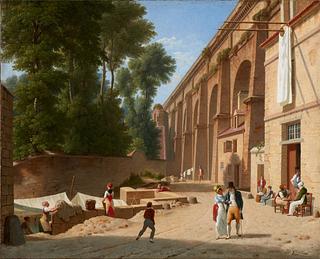C.W. Eckersberg (1783–1853)
The Aqueduct at Arcueil, 1812
Oil on canvas
32.5 x 40.5 cm
Inventory number 4/2020
In his diary covering the years 1810 to 1813, C.W. Eckersberg made notes of his numerous excursions in and around Paris. His sojourns included visits to the suburb of Arcueil, where he did several drawings and sketches for later use as the basis for oil paintings. Among them is this painting, The Aqueduct at Arcueil, which, together with its counterpart, The Longchamp Gate in the Bois-de-Boulogne (16/1969), was completed in Paris in December 1812.
A feature shared by both works is that Eckersberg has chosen subjects that cut across several genres within the art of painting, namely city prospects, genre scenes and landscapes. Another common trait is that both works reflect Eckersberg’s interest in linear perspective, which would later greatly influence his art and his teaching at the Royal Danish Academy of Fine Arts in Copenhagen.
Paris was where Eckersberg first used carefully planned and calculated perspectival constructions to assist his depictions of the world around him. He most frequently based these on the city’s architecture – in this case the aqueduct in Arcueil, which was built in 1613–1623. The aqueduct moves from the right side of the painting into the pictorial space, after which it disappears behind the tall deciduous trees that spread out on the left side of the painting, emphasising the rural nature of the setting. Eckersberg’s choice of a tight, but also quite complex approach to perspectival construction may perhaps be due to the fact that he specifically wanted to work with perspective lines.1 The light and colours play an important role, too. The light blue summer sky, the white sheet hanging along the aqueduct, and the clothes of the working, resting and strolling people are among the finest features in this evocative depiction of everyday life in Arcueil.
A feature shared by both works is that Eckersberg has chosen subjects that cut across several genres within the art of painting, namely city prospects, genre scenes and landscapes. Another common trait is that both works reflect Eckersberg’s interest in linear perspective, which would later greatly influence his art and his teaching at the Royal Danish Academy of Fine Arts in Copenhagen.
Paris was where Eckersberg first used carefully planned and calculated perspectival constructions to assist his depictions of the world around him. He most frequently based these on the city’s architecture – in this case the aqueduct in Arcueil, which was built in 1613–1623. The aqueduct moves from the right side of the painting into the pictorial space, after which it disappears behind the tall deciduous trees that spread out on the left side of the painting, emphasising the rural nature of the setting. Eckersberg’s choice of a tight, but also quite complex approach to perspectival construction may perhaps be due to the fact that he specifically wanted to work with perspective lines.1 The light and colours play an important role, too. The light blue summer sky, the white sheet hanging along the aqueduct, and the clothes of the working, resting and strolling people are among the finest features in this evocative depiction of everyday life in Arcueil.
Published in
Published in
Fortegnelse over de ved det Kongelige Maler-, Billedhugger- og Bygnings-Academie udstillede Kunstsager, Kiöbenhavn 1814, no. 13;
Philip Weilbach: Maleren Eckersbergs Levned og Værker, København 1872, pp. 215-216;
Udstillingen af C.W. Eckersberg’s Malerier i Kunstforeningen, Oktober-November 1895, København 1895, cat. 67;
Emil Hannover: Maleren C.W. Eckersberg: En Studie i dansk Kunsthistorie, Kunstforeningen, København 1898, no. 120, pp. 327;
C.W. Eckersberg: Forsög til en Veiledning i Anvendelsen af Perspectivlæren for unge Malere, Kiöbenhavn 1933;
V. Winkel & Magnussen (ed.): Kunst i privat Eje. Bd 3, Provinsen, København 1945, fig. 1, pp. 134-135;
Henrik Bramsen (ed.): C.W. Eckersberg i Paris, Dagbog og Breve, 1810-13, København 1947, pp. 99 og 136, (the title given here : Landskab under Vandledningen i Arcueil ved Paris);
Knud Voss: Guldalderens malerkunst. Dansk arkitekturmaleri 1800-1850, København 1968, fig. 15, pp. 42-44;
Hanne Jönsson (ed.): C.W. Eckersberg og hans elever. Udstilling i anledning af 200 året for kunstnerens fødsel: 2. januar - 10. april 1983, Statens Museum for Kunst, København 1983, pp. 18-19 and cat. 13, p. 74;
Charlotte Christensen: ”Om store og små profeter i det danske guldaldermaleri”, in Gutenberghus årsskrift 1983, København 1983, pp. 7-8;
Kasper Monrad in L’âge d’or de la peinture danoise 1800-1850, Grand Palais, Paris 1984, p. 123.
Torsten Gunnarsson: Friluftsmåleri före friluftsmåleriet. Oljestudien i nordiskt landskapsmåleri 1800-1850 = Open-air oil sketching in Scandinavia 1800-1850 : with a survey of the development of the landscape oil sketch in Europe, c. 1630-1850, Uppsala 1989, p. 60, ill. 39;
Philip Conisbee, Kasper Monrad, Lene Bøgh Rønberg: Christoffer Wilhelm Eckersberg, 1783-1853, National Gallery of Art, Washington 2003, fig. 13, pp. 39-40 and p. 70;
Peter Michael Hornung and Kasper Monrad: C.W. Eckersberg – dansk malerkunsts fader, København 2005, p. 109;
C.W. Eckersbergs dagbøger, ed. Villads Villadsen, København 2009. Vol. 1, 1810-1836, p. 73, note 9 and pp. 82-83, note 2;
Markus Bertsch: “Christoffer Wilhelm Eckersberg. Facetten seines bildnerrischen Denkens” in Markus Bertsch, Hubertus Gassner og Neela Struck (eds.): Eckersberg – Faszination Wirklichkeit: das goldene Zeitalter der dänischen Malerei, Hamburger Kunsthalle, Petersberg 2016, pp. 39-40;
Gry Hedin: ”Billedkonstruktion. Kunsten at se med ét øje” in Kasper Monrad et al.: Eckersberg, Statens Museum for Kunst, København 2015, fig. 136, pp. 153-155;
Jan Gorm Madsen: ”Paris avant Rome 1810-1813, le sejour de parisien” in Kasper Monrad et al.: C. W. Eckersberg 1783-1853: artiste danois à Paris, Rome & Copenhague, Fondation Custodia, Paris 2016, cat. 14, pp. 142-143.
Philip Weilbach: Maleren Eckersbergs Levned og Værker, København 1872, pp. 215-216;
Udstillingen af C.W. Eckersberg’s Malerier i Kunstforeningen, Oktober-November 1895, København 1895, cat. 67;
Emil Hannover: Maleren C.W. Eckersberg: En Studie i dansk Kunsthistorie, Kunstforeningen, København 1898, no. 120, pp. 327;
C.W. Eckersberg: Forsög til en Veiledning i Anvendelsen af Perspectivlæren for unge Malere, Kiöbenhavn 1933;
V. Winkel & Magnussen (ed.): Kunst i privat Eje. Bd 3, Provinsen, København 1945, fig. 1, pp. 134-135;
Henrik Bramsen (ed.): C.W. Eckersberg i Paris, Dagbog og Breve, 1810-13, København 1947, pp. 99 og 136, (the title given here : Landskab under Vandledningen i Arcueil ved Paris);
Knud Voss: Guldalderens malerkunst. Dansk arkitekturmaleri 1800-1850, København 1968, fig. 15, pp. 42-44;
Hanne Jönsson (ed.): C.W. Eckersberg og hans elever. Udstilling i anledning af 200 året for kunstnerens fødsel: 2. januar - 10. april 1983, Statens Museum for Kunst, København 1983, pp. 18-19 and cat. 13, p. 74;
Charlotte Christensen: ”Om store og små profeter i det danske guldaldermaleri”, in Gutenberghus årsskrift 1983, København 1983, pp. 7-8;
Kasper Monrad in L’âge d’or de la peinture danoise 1800-1850, Grand Palais, Paris 1984, p. 123.
Torsten Gunnarsson: Friluftsmåleri före friluftsmåleriet. Oljestudien i nordiskt landskapsmåleri 1800-1850 = Open-air oil sketching in Scandinavia 1800-1850 : with a survey of the development of the landscape oil sketch in Europe, c. 1630-1850, Uppsala 1989, p. 60, ill. 39;
Philip Conisbee, Kasper Monrad, Lene Bøgh Rønberg: Christoffer Wilhelm Eckersberg, 1783-1853, National Gallery of Art, Washington 2003, fig. 13, pp. 39-40 and p. 70;
Peter Michael Hornung and Kasper Monrad: C.W. Eckersberg – dansk malerkunsts fader, København 2005, p. 109;
C.W. Eckersbergs dagbøger, ed. Villads Villadsen, København 2009. Vol. 1, 1810-1836, p. 73, note 9 and pp. 82-83, note 2;
Markus Bertsch: “Christoffer Wilhelm Eckersberg. Facetten seines bildnerrischen Denkens” in Markus Bertsch, Hubertus Gassner og Neela Struck (eds.): Eckersberg – Faszination Wirklichkeit: das goldene Zeitalter der dänischen Malerei, Hamburger Kunsthalle, Petersberg 2016, pp. 39-40;
Gry Hedin: ”Billedkonstruktion. Kunsten at se med ét øje” in Kasper Monrad et al.: Eckersberg, Statens Museum for Kunst, København 2015, fig. 136, pp. 153-155;
Jan Gorm Madsen: ”Paris avant Rome 1810-1813, le sejour de parisien” in Kasper Monrad et al.: C. W. Eckersberg 1783-1853: artiste danois à Paris, Rome & Copenhague, Fondation Custodia, Paris 2016, cat. 14, pp. 142-143.
Footnotes
Footnotes
1.
Gry Hedin: ‘Billedkonstruktion. Kunsten at se med ét øje’ in Kasper Monrad and et al.: Eckersberg, SMK – The National Gallery of Denmark, Copenhagen 2015, p. 154.
Danish Paintings and Drawings
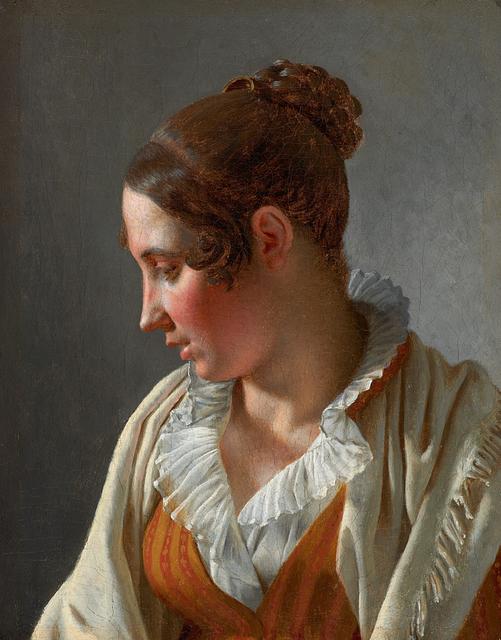
C.W. Eckersberg (1783–1853)
The model Emilie, 1813
Oil on canvas
The model Emilie, 1813
Oil on canvas
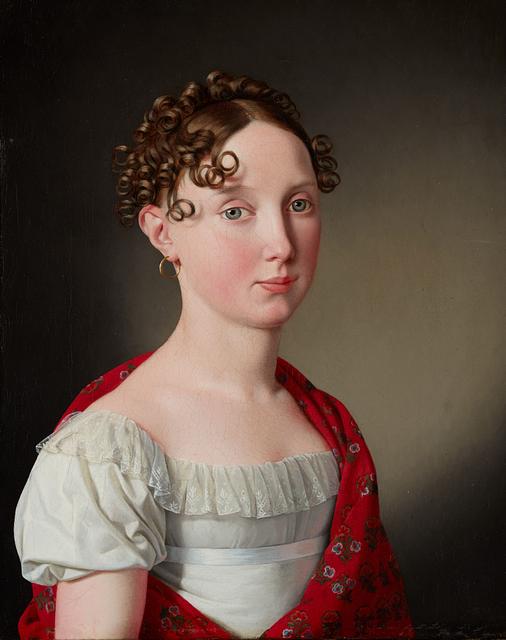
C.W. Eckersberg (1783–1853)
Elisabeth Ida Mariane Brockenhuus, 1817
Oil on canvas
Elisabeth Ida Mariane Brockenhuus, 1817
Oil on canvas
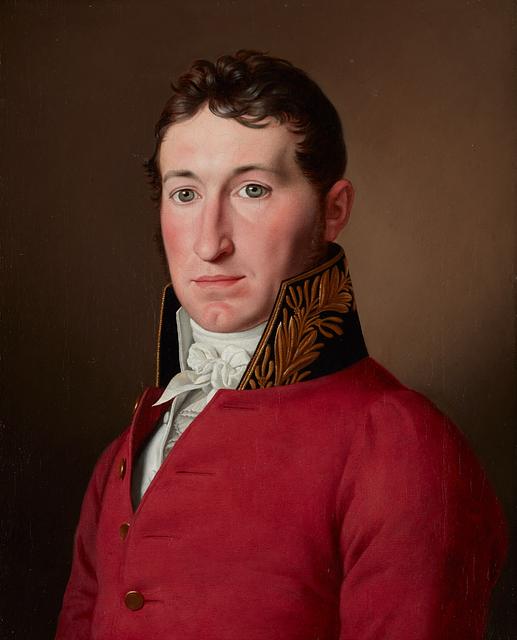
C.W. Eckersberg (1783–1853)
Frederik von Lowzow, 1817
Oil on canvas
Frederik von Lowzow, 1817
Oil on canvas
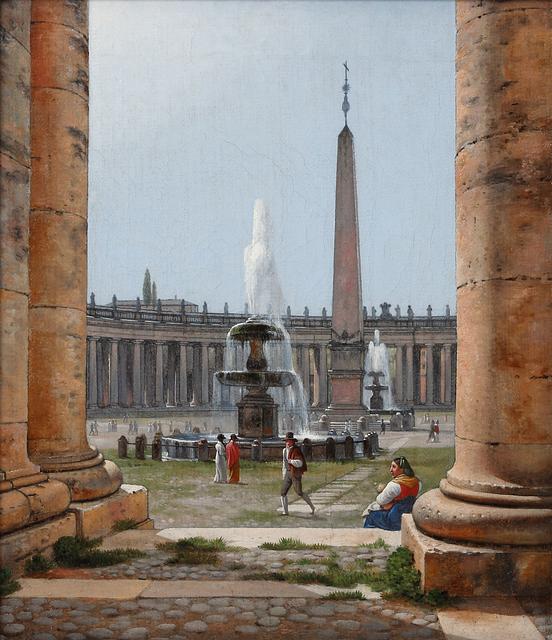
C.W. Eckersberg (1783–1853)
View of the Colonnade, St. Peter’s Square, 1814–1816
Oil on canvas
View of the Colonnade, St. Peter’s Square, 1814–1816
Oil on canvas
